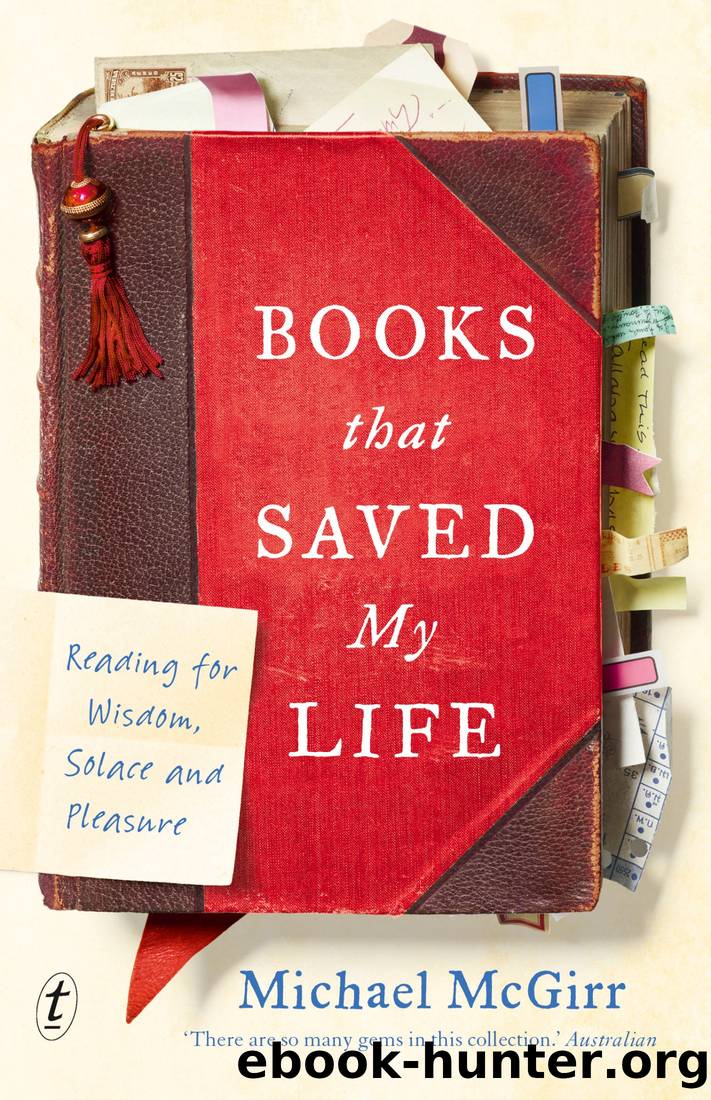Books That Saved My Life: Reading for Wisdom, Solace and Pleasure by Michael McGirr

Author:Michael McGirr [McGirr, Michael]
Language: eng
Format: epub
Tags: Literary Criticism, Books & Reading, Biography & Autobiography, Personal Memoirs, General, Literary Figures
ISBN: 9781925774054
Google: 399kDwAAQBAJ
Publisher: Text Publishing
Published: 2018-10-29T23:22:00.781953+00:00
Much as I love Orwell, I am firmly on the side of Chesterton when it comes to this. Dickens has been one of the liberators of my life. The first time I laughed aloud with a book in my hands was as a sixteen-year-old who had stumbled into The Pickwick Papers when he should have been playing sport before school; I still havenât fully found my way out of Dickens.
CHAPTER 22
A Local Habitation and a Name
Joseph Furphy, Such Is Life (1903)
Mark Twain claimed to be the first author in history to submit a typewritten manuscript. Technology did little to enhance his prose, but Twain loved gadgets.
The manuscript of Tom Sawyer was, as the word implies, written longhand. Originally, Aunt Polly was introduced as she asked of young Tom, âWhere is that boy?â Twain crossed out those words and replaced them with Pollyâs now-famous utterance: âWhatâs gone with that boy?â The reader hears Pollyâs voice a page before learning her name. Itâs Pollyâs voice which creates her character. Twain is renowned for having something to say about everything. But his genius came from his ability to listen. He heard voices and they were real.
Twain shared that capacity with an Australian writer who rivals Twainâs brand of mercurial genius: Joseph Furphy. Furphy is really known for a single book. Such Is Life has frustrated and infuriated readers down the decades with its tangled plot, recondite humour and long-winded digressions on every subject from the practical to the arcane, from mechanics to philosophy. At the same time, the book has won a band of admirers who place it in a class of its own in the history of Australian writing. I am one of the latter, though I have served my time among the former. It is a book worth the struggle. At some point most readers stop scratching their heads and break into laughter. For some reason, that moment for me was when the narrator, Tom Collins, offers his views on the oxide of hydrogen. He means water. In a book about bullockies, a species of worker which no longer exists, set during the drought and depression of the early 1890s, I was able to recognise something of my own pretentiousness.
Tom Collins is a man of such absurd modesty that, in the company of bullockies, he insists on using âsanguinaryâ for âbloodyâ and âsheolâ for âhellâ. In one of the best-known passages of the book, he finds himself skulking naked along the banks of the Murray because his clothes are on their way to South Australia, lost in the river. Collins canât bring himself to mention by name the item of clothing, essential to his dignity, which he spends the next thirty pages trying to secure. But later in the book, he finds himself standing naked in front of Nosey Alf Morris, a stockman whom the reader has long ago realised is a woman in disguise. Collins himself is oblivious to this. Gender identity is one of the recurring themes of Such Is Life.
Download
This site does not store any files on its server. We only index and link to content provided by other sites. Please contact the content providers to delete copyright contents if any and email us, we'll remove relevant links or contents immediately.
Machine Learning at Scale with H2O by Gregory Keys | David Whiting(4094)
Never by Ken Follett(3758)
Harry Potter and the Goblet Of Fire by J.K. Rowling(3757)
Unfinished: A Memoir by Priyanka Chopra Jonas(3313)
Fairy Tale by Stephen King(3192)
The Man Who Died Twice by Richard Osman(2977)
Will by Will Smith(2766)
Rationality by Steven Pinker(2271)
The Dark Hours by Michael Connelly(2211)
It Starts With Us (It Ends with Us #2) by Colleen Hoover(2171)
The Storyteller by Dave Grohl(2147)
Can't Hurt Me: Master Your Mind and Defy the Odds - Clean Edition by David Goggins(2141)
The Dawn of Everything: A New History of Humanity by David Graeber & David Wengrow(2103)
Friends, Lovers, and the Big Terrible Thing by Matthew Perry(2097)
The Becoming by Nora Roberts(2057)
The Stranger in the Lifeboat by Mitch Albom(2030)
Cloud Cuckoo Land by Anthony Doerr(2012)
Einstein: His Life and Universe by Walter Isaacson(1952)
Love on the Brain by Ali Hazelwood(1931)
